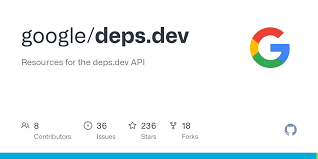Introducing deps.dev API: Google's API to identify vulnerabilities effectively
 Ujjwal Jha
Ujjwal Jha
In our fast-paced software development landscape, ensuring security is always at the forefront of our minds. As developers, we understand the importance of identifying and mitigating vulnerabilities within our codebase to build resilient and secure applications. That's why I'm thrilled to share with you a remarkable development from Google – the introduction of dips.dev API. This groundbreaking API takes vulnerability detection to new heights, empowering us to tackle potential security loopholes with greater effectiveness. In this article, let's explore the remarkable features and benefits of dips.dev API and discover how it can revolutionize vulnerability detection in our software development journey.

Before diving into the blog, let's look at Dependency Vulnerabilities. Dependency vulnerabilities refer to security weaknesses or flaws present in the external libraries, frameworks, or components that a software application relies on. These dependencies are essential for modern software development as they provide pre-built functionality and save time and effort for developers.
However, dependency vulnerabilities can pose significant challenges for software development due to inherited risks, complex dependency networks, dependency chain risks, and lack of awareness, patching and updates.
Key Features and Benefits
Extensive Package Database: Access a vast repository of information on open-source packages, encompassing a wide range of programming languages and frameworks.
Version Tracking: Track the evolution of packages over time, including updates, bug fixes, and new features.
License Compliance: Ensure your projects adhere to licensing requirements by easily accessing license details for each package.
Dependency Analysis: Visualize the complex relationships between packages in your project, helping you understand potential vulnerabilities and dependencies.
Vulnerability Alerts: Receive real-time notifications about newly discovered vulnerabilities in your project's dependencies, allowing you to take swift action.
How to Use deps.dev API
API Access: Obtain an API key to authenticate your requests and access the API's capabilities.
API Requests: Make HTTP requests to the API endpoint, specifying the desired package or vulnerability information.
Data Parsing: Parse the API response to extract the relevant data, such as package versions, vulnerabilities, or dependency relationships.
Integration: Integrate the API into your development workflow to automate vulnerability checks and security assessments.
Real-World Use Cases
Security Audits: Conduct regular security audits to identify vulnerabilities in your project's dependencies.
Dependency Management: Optimize your dependency management practices by selecting the most secure and compatible package versions.
Open-Source Governance: Ensure your open-source projects adhere to best practices for security and licensing.
DevOps Integration: Integrate deps.dev API into your CI/CD pipelines to automate vulnerability scanning and remediation.
The deps.dev API is an essential tool for developers that prioritises code security and maintainability. By leveraging its capabilities, you can proactively address vulnerabilities, improve your project's resilience, and build trust with your users.
Subscribe to my newsletter
Read articles from Ujjwal Jha directly inside your inbox. Subscribe to the newsletter, and don't miss out.
Written by
